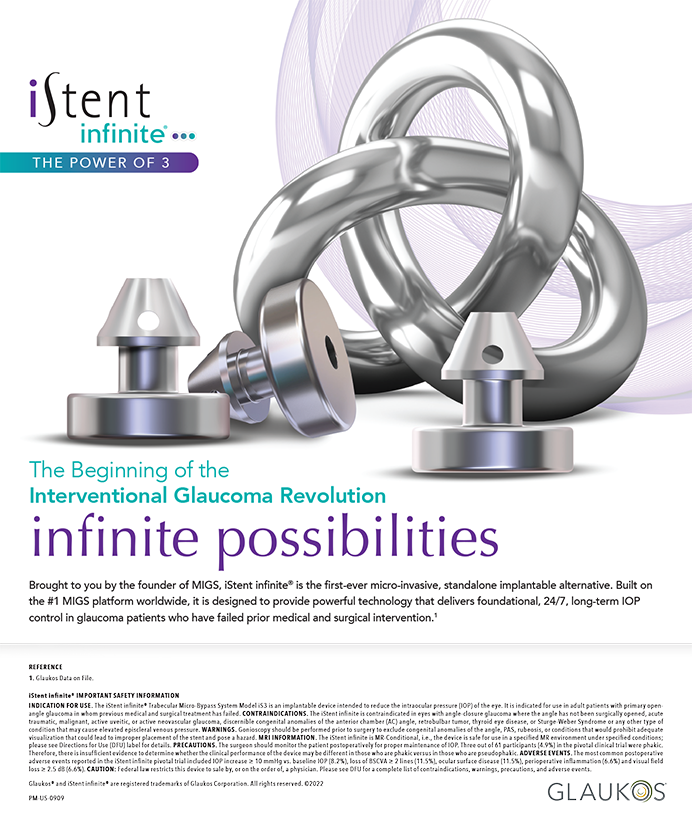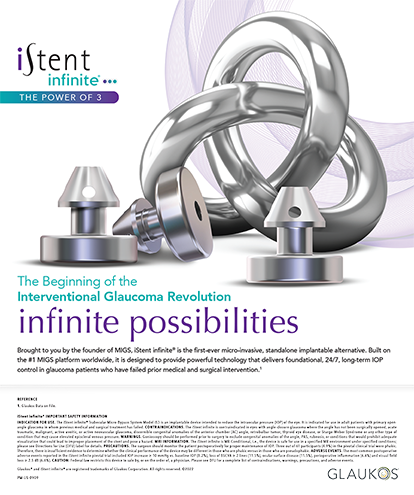The superiority of surface or lamellar excimer laser surgery is a long-running debate in ophthalmology. In general, although different studies find LASIK and PRK to be similar in longer-term follow-up, patients achieve better results with LASIK through the 1- to 6-month postoperative period. As a result, LASIK is the procedure of choice for many ophthalmologists. It is a better operation than PRK in terms of safety and efficacy, according to a Cochrane methodology meta-analysis,1 although most of the literature cited in this study dates to before 2001. More recently, surface ablation has generated renewed interest, because surgeons perceive it as a safer procedure in terms of ectasia.
What if there is a better technique, a hybrid of the two procedures that combines the faster recovery and greater comfort of LASIK with any safety-related advantages of PRK? For several years, I have worked to customize the LASIK flap to the patient much as we surgeons individualize the ablation to the patient. I have named this technique sub-Bowman's keratomileusis.
PROSPECTIVE COMPARISON
In an attempt to address the debate over surface versus lamellar procedures, Daniel S. Durrie, MD, of Overland Park, Kansas, and I recently completed a clinical study comparing PRK with sub-Bowman's keratomileusis. We used a small-diameter (8 mm), thin (≤ 100 µm) flap. Our goal was to create a prospective, randomized study using a contralateral eye design to match the subject groups as evenly as possible. We also agreed to use current technology and methods so that all patients underwent customized ablation. We performed PRK using an established technique and created all flaps with a 60-kHz femtosecond laser (IntraLase FS Laser; Advanced Medical Optics, Inc., Santa Ana, CA).
In some respects, our results confirmed what many of us ophthalmologists had suspected, and they led us to conclude that sub-Bowman's keratomileusis may be just what we expected, a hybrid of PRK and LASIK. This new procedure may offer the biomechanical stability of surface ablation with the quicker visual recovery and relatively pain-free experience of LASIK.
CLINICAL RESULTS
Our study of 50 patients (100 eyes) was conducted at two sites (Houston and Overland Park) in the spring of 2006. One eye of each patient underwent a femtosecond-laser-assisted LASIK procedure (with an intended flap thickness of 100 µm), and the fellow eye underwent a PRK procedure. Because it was a contralateral study, the two groups were almost evenly matched in terms of preoperative mean refractive error. The femtosecond laser group had an average refractive error of -3.64 D (range, -2.00 to -5.75 D; SD = 0.97), and the mean manifest cylindrical refraction was -0.63 D (range, 0 to -3.00 D). The PRK group had an average refractive error of -3.68 D (range, -2.00 to -5.75 D; SD = 1.06), with a mean manifest cylindrical refraction of -0.64 D (range, 0 to -2.75 D). The mean preoperative BSCVA was 20/17 in both groups, with a range of 20/12 to 20/20 (SD = 2.47).
Because we wanted to analyze the outcomes and also look at the biomechanical effects that the two surgical approaches had on the cornea, we utilized both standard and new diagnostic testing. The modalities included corneal topography, wavefront aberrometry (LadarWave; Alcon Laboratories, Inc., Fort Worth, TX), contrast visual acuity, corneal sensitivity (Cochet-Bonnet aesthesiometer; Luneau Ophthalmologie, Chartres, France), Visante OCT imaging (Carl Zeiss Meditec, Inc., Dublin, CA), corneal hysteresis (Ocular Response Analyzer, Reichert, Inc., Depew, NY), corneal response factor, light scatter, and optical visual acuity assessment (OQAS; Visiometrics, Barcelona, Spain). At Dr. Durrie's clinic, patients underwent two additional tests: confocal microscopy and Artemis High-Frequency Ultrasound Imaging (Ultralink LLC, St. Petersburg, FL).
Although the full results from our study should be published later in the year if accepted, we can report that the visual results confirmed that the femtosecond laser group experienced a quicker return to functional vision than the PRK group. In fact, 100 of the femtosecond eyes could see 20/40 uncorrected on the first postoperative day compared with 42 in the PRK group. At 1 month postoperatively, 88 of the femtosecond eyes saw 20/20 or better uncorrected compared with 48 of the PRK eyes.
The femtosecond-laser group also had lower levels of higher-order aberrations (coma and spherical aberration) at 1 and 3 months than eyes in the PRK group. High and low contrast acuity and retinal image quality also favored the femtosecond group. More importantly, patients preferred their femtosecond-laser eye to the PRK eye and cited less pain and better vision during the first 3 months postoperatively.
Measurements with optical coherence tomography showed that the flaps created with the femtosecond laser had a uniform (planar) thickness (mean = 112 ±5 µm; range, 87 to 118 µm). The average standard deviation in flap thickness was 4 µm.
Dr. Durrie and I evaluated the patients' biomechanical results using the Ocular Response Analyzer and the Pascal Dynamic Contour Tonometer (Ziemer USA, Inc., Wood River, IL). These relatively new devices measure how the cornea responds to biomechanical changes. According to our results, the eyes in the femtosecond group were statistically significantly better than the PRK eyes in terms of biomechanical stability. Interestingly, none of the tests showed that PRK had a biomechanical advantage over a flap-based approach, although the clinical significance of the Ocular Response Analyzer and the Pascal tonometer still needs to be proven.
John Marshall, PhD, of London, has led the way in investigating the strength of an eye after sub-Bowman's keratomileusis versus PRK. He has studied human cadaveric eyes and believes that both procedures are virtually indistinguishable in terms of biomechanical stability. In fact, with the effect of wound healing, Dr. Marshall told me that he believes an eye after sub-Bowman's keratomileusis may indeed be stronger than PRK.
THE NEW "K" IN REFRACTIVE SURGERY
Many surgeons are already performing laser vision correction with a femtosecond laser or a mechanical microkeratome and regularly creating a flap of 100 µm or less. What is the difference between this technique and sub-Bowman's keratomileusis?
Dr. Durrie and I defined sub-Bowman's keratomileusis as a customized corneal flap based on the requirements of the patient as well as the type of excimer laser and ablation used. The intended thickness is between 90 and 110 µm. In our study discussed earlier, the diameter of the corneal flap was 8 mm. However, in my practice, I routinely use flaps with diameters of between 7 and 8 mm, depending on the excimer laser and ablation pattern I am using.
A key to creating the flap during sub-Bowman's keratomileusis is the surgeon's ability to establish a planar corneal flap with a consistent thickness across the entire area. Although there are a number of mechanical microkeratomes that can create a 100-µm flap, the reality is that these devices tend to produce a flap that is more of a meniscus in shape?thicker in the periphery and thinner in the center. The most consistent, predictable device for creating a sub-Bowman's keratomileusis flap is a femtosecond laser.2-5
There are many more parameters in which we can customize flaps. We are looking at shaping the flap's edge to improve its strength, controlling its depth by detecting variations in the epithelium, and using oval flaps for astigmatism.
WHAT DO PATIENTS WANT?
Recently, refractive surgery volumes have been relatively flat or have even declined. In many respects, this downturn is related to the drawbacks associated with the two procedures we currently perform. With PRK, patients must cope with pain, haze, and slow visual recovery. With LASIK, there is an increased incidence of dry eye, halos, and glare as well as a risk of corneal ectasia.
In our study, we found that there was better vision with less fluctuation through 1 month postoperatively in the sub-Bowman's keratomileusis group. These eyes also experienced less dry eye, double and blurry vision, glares/halos, sensation of grittiness, and difficulty with driving at night through 3 months postoperatively. Overwhelmingly, patients preferred the vision in their sub-Bowman's keratomileusis eye out to 3 months postoperatively by a margin of two to one.
By 6 months postoperatively, the results in the two subject groups became relatively equal. Patients, however, make up their minds about the success or failure of their laser vision procedure in the first few postoperative months. More importantly, it is during this time that they will talk to their family and friends about their experiences. Certainly more research is warranted. With sub-Bowman's keratomileusis, however, we may now have a technique that enables us to offer the best of PRK and LASIK without the negatives, thereby allowing us to restore the "wow" to refractive surgery.
Stephen G. Slade, MD, is in private practice in Houston. He is a consultant for Advanced Medical Optics, Inc., and Alcon Laboratories, Inc. Dr. Slade may be reached at (713) 626-5544; sgs@visiontexas.com.


